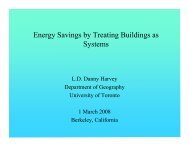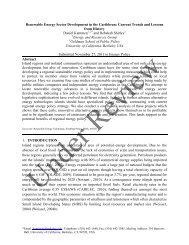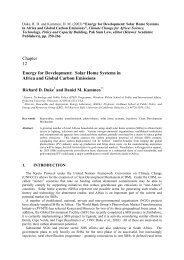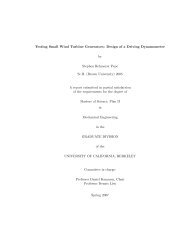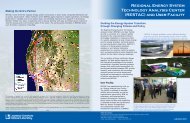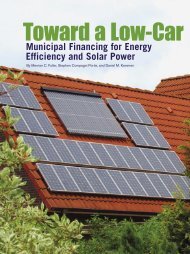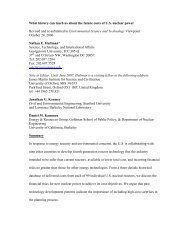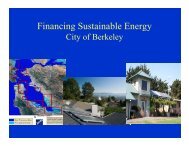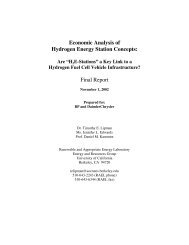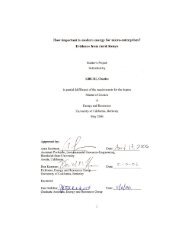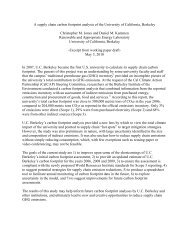Informing the Financing of Universal Energy Access: An Assessment ...
Informing the Financing of Universal Energy Access: An Assessment ...
Informing the Financing of Universal Energy Access: An Assessment ...
Create successful ePaper yourself
Turn your PDF publications into a flip-book with our unique Google optimized e-Paper software.
ELECTR-5744; No <strong>of</strong> Pages 26Table 2: Overview <strong>of</strong> GFCF for Electricity and Gas Distribution (USD billion) [constant 2000 prices].2000 2001 2002 2003 2004 2005 2006 2007 2008 2009 aOECD 179.1 183.0 175.1 174.3 168.3 173.3 191.8 211.6 222.7 172.2Non-OECD b 53.5 58.3 60.1 71.2 77.0 84.8 98.1 123.4 153.4 144.5LDC 1.3 1.4 1.6 1.6 1.7 1.9 2.0 2.3 2.5 2.6Global 232.6 241.3 235.2 245.5 245.3 258.1 289.9 335.0 376.1 316.6a Incomplete; <strong>the</strong> sharp decrease is due to <strong>the</strong> economic crisis as well as to <strong>the</strong> fact that <strong>the</strong> dataset is incomplete at <strong>the</strong> date <strong>of</strong> writing.b This row includes <strong>the</strong> LDC figures.exception <strong>of</strong> 2009 (Table 2). At <strong>the</strong>regional level, <strong>the</strong> trends aresimilar, although not quite asclear-cut. GFCF for electricity andgas distribution in <strong>the</strong> OECD wasstagnant or decreasing between2000 and 2005, before picking upsharply. In <strong>the</strong> LDCs, GFCF inelectricity and gas distributionhas doubled in a decade, although<strong>the</strong> absolute value remains low.B y way <strong>of</strong> comparison, IEA(2003) estimated <strong>the</strong> worldinvestment in electricity and gas 26in 2000 at USD 315 billion.UNFCCC (2007) estimated, basedon UNCTAD and OECD data, <strong>the</strong>investment in electricity and gasdistribution reaching USD 216billion in 2000. Eberhard et al.(2011) also provide very usefulanalysis on investment in 24countries <strong>of</strong> sub-Saharan Africa(SSA). 27Figure 2 shows <strong>the</strong> relativeevolution in energy-related GFCFin selected 28 developing countries.The country datasets arenormalized in 2000 to reveal <strong>the</strong>trends in <strong>the</strong> recent years. Thecurves for Namibia and, to a lesserextent, Armenia, urge for cautionin interpreting <strong>the</strong> data, since <strong>the</strong>flows are subject to significantfluctuations, particularly if <strong>the</strong>yare relatively small in absoluteterms. Also, wide variations urgefor caution in <strong>the</strong> interpretation <strong>of</strong><strong>the</strong> datasets.T his notwithstanding, <strong>the</strong>analysis indicates a clearpositive trend overall. That beingnoted, <strong>the</strong> rate <strong>of</strong> increase variesgreatly between <strong>the</strong> countries(+60 percent and +160 percent forBotswana and India, respectively,over 10 years). Interestingly, <strong>the</strong>trend is in some cases negative, asFigure 2: Relative Trends in <strong>Energy</strong>-Related GFCF in Selected Developing Countries [constant 2000 USD]6 1040-6190/$–see front matter # 2011 Elsevier Inc. All rights reserved., doi:/10.1016/j.tej.2011.07.006 The Electricity JournalPlease cite this article in press as: Bazilian M, have surnames. <strong>Informing</strong> <strong>the</strong> <strong>Financing</strong> <strong>of</strong> <strong>Universal</strong> <strong>Energy</strong> <strong>Access</strong>: <strong>An</strong> <strong>Assessment</strong> <strong>of</strong> Current Financial FlowsElectr. J. (2011), doi:10.1016/j.tej.2011.07.006



